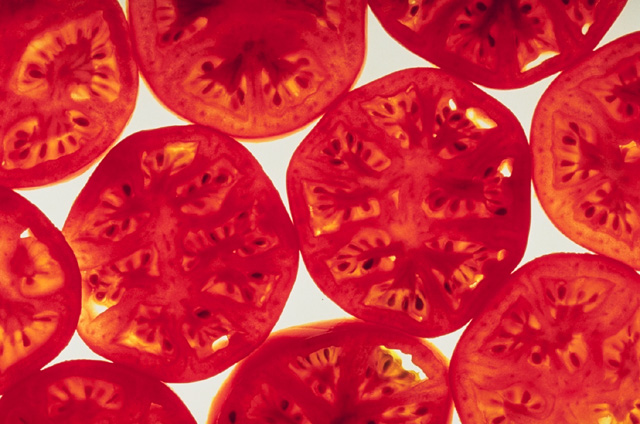There is a establishment in my current city that supposedly invented the hamburger. At this place they don't allow you to have any ketchup on your burger, and get angry if you ask for it. Now, this behavior seems very off-putting, and the folks at this place seem to take their so-so burgers a bit too seriously to be howling at customers who ask for a certain red condiment. On the other side of this social equation is the simple fact that the aforementioned condiment has become a truly foul, syrupy concoction with little resemblance to the true, undinted character of the wonderful condiment that it could be.
So, maybe it is time for a compromise - let the customers use ketchup, but not prolefood ketchup - real, bold, sweet, sour, exotic ketchup that takes time and attention.
Exotic Ketchup*
- A quantity of tomatoes (depending on the time of year, fresh or canned)**
- An onion or so
- Vinegar***
- A sweetening agent (sugar, brown sugar, agave, choose your favorite)
- A creatively unrestrained spice blend (Some standbys would be cinnamon sticks, star anise, cloves, and bay leaves - but please go as far as your taste allows)
To start, the tomato factor. Some people are used to a very thick, glue-like ketchup. Now that I have connected this type of ketchup with a generally inedible substance, I hope you all will find it repulsive. However, if you find your ketchup to be a bit thin or watery, you can always add some tomato paste to your basic tomato base to thicken things up. Please do try the lighter version at least once though.
With that out of the way, you will need to get your tomatoes to a somewhat smooth consistency. Here is one place where I might suggest a quick whizz in a blender or food processor. If you happen to have the luck of owning a manual food mill, please use it. Your end result should be quite smooth with no recognizable protuberances peeking out. Now, do the same to your onion. Get it into a kind of onion slop, it might help if you add a bit of the smooth tomato to pull things together.
Snag a good-sized pot, a bit of oil (but not too much) and cook the onion slop for a bit until it releases some of its flavour. Add your smooth tomato now and get things boiling. Now for the sweet and sour. I don't give amounts above, but start with a smaller bit of each. The ratio should be something like 2 parts sweet to 3 parts sour. Give a taste after stirring things up and see how it strikes you at first blush. Don't get too enthusiastic here, as you can always adjust things later on to your liking.
Snag a good-sized pot, a bit of oil (but not too much) and cook the onion slop for a bit until it releases some of its flavour. Add your smooth tomato now and get things boiling. Now for the sweet and sour. I don't give amounts above, but start with a smaller bit of each. The ratio should be something like 2 parts sweet to 3 parts sour. Give a taste after stirring things up and see how it strikes you at first blush. Don't get too enthusiastic here, as you can always adjust things later on to your liking.
Pull your mixture down to a gentle simmer and allow it to find itself for about an hour. During this time, you could mix yourself a Campari with some white wine, or something relatively uninvolved. You'll want to keep an eye on things, and give them a stir from time to time so perhaps continuing on your translation of Bourdieu's Esquisse d'une théorie de la pratique would be better saved for another time. The time spent simmering will directly affect your thickness factor. So, if you would like a thicker batch, give it another hour or more. Just keep an eye on things so that nothing burns.
Your final step is to make your ketchup exotic. Make some sort of packet in which your spices can be contained. You could use a clean sock, a piece of cheesecloth****, a tea ball, or any other containment device that will keep your spices inside while simultaneously lending flavour to your ketchup. Allow your spices 30 minutes or so in the ketchup, don't overdo it, otherwise your ketchup will take on a kind of potpourri funk that might be less than appealing.
Now, cool your ketchup, pack in jars and use on everything. Enjoy the sweet and sour elements, and the boldness of tomato.
* There is a dissertation to be written on the etymology of ketchup. Look it up, there are like forty theories on where the word came from, as well as its spelling. I'll use ketchup because I find catsup a somewhat annoying word.
** If you use fresh, you'll need to peel them. Otherwise you will have skins floating around in your end product. Any easy way to peel is to dip them in boiling water for a bit, then cold water. They will peel like lady's stockings.
*** I plan to post on making your vinegar soon. In the meantime, use one that doesn't come from petroleum distillates (white vinegar).

No comments:
Post a Comment